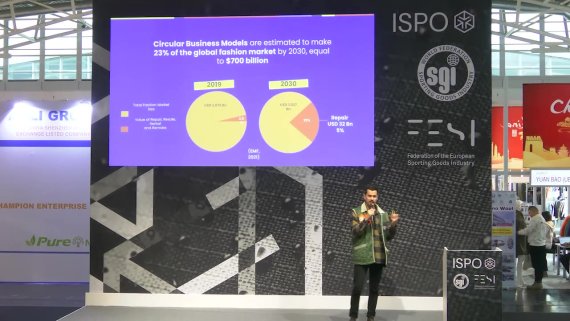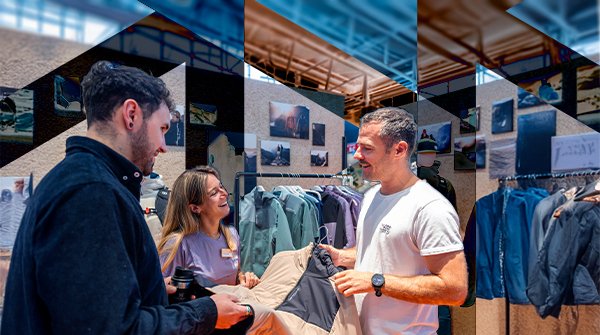- Sustainability starts with people
- From the linear supply chain to the circular economy
- The United Repair Center: Sustainability as a service
- Repair services strengthen customer loyalty
- Why repair services are becoming increasingly relevant for the sports and fashion industry
- Conclusion: The most important key learnings for the sports industry
Every second, a truckload of clothing ends up as waste. But the real burden is borne by people in countries such as Ghana, where around 10 million items of clothing end up as waste every week. Many earn their living by reselling these clothes - often under difficult conditions and with physical consequences. They carry these clothes on their heads to markets, often with loads of up to 50 kilograms.
Sustainability therefore not only affects materials and production processes, but also the people along the entire supply chain. Sustainable change begins with a change of perspective: who produces, sells and disposes of our clothing - and what responsibility do we bear as an industry?

For a long time, the textile industry followed a linear model: clothing was produced, sold and finally disposed of. But this system is coming under increasing pressure. A circular economy in which clothing is used for longer and recycled is becoming increasingly important. Repairs play a central role in this - they extend the lifespan of textiles and help to save valuable resources.
Three factors in particular are crucial for this change
More conscious consumers
Gen Z in particular is changing its buying habits and showing a growing interest in sustainable fashion. According to McKinsey & Co (2021), 75% of millennials also prefer brands that are committed to sustainability.New business models
Second-hand programs, rental models and take-back systems are becoming increasingly important. These innovations strengthen the competitiveness of brands and make sustainable fashion more attractive.Legal requirements
Regulations are forcing companies to take responsibility for the entire life cycle of their products. By offering repair services, companies can actively contribute to extending the life of their products.
According to forecasts, the market for circular fashion will grow to 23% by 2030. Repair services make a significant contribution to this - through resale, rental models or warranty services. This is the only way the sports and fashion industry can evolve from a throwaway model to a sustainable circular economy.

This is exactly where the United Repair Center (URC) comes in. The company has set itself the goal of extending the lifespan of clothing and thereby reducing waste and the waste of resources. As a one-stop store, URC offers brands a complete infrastructure for repairs - from logistics and digital solutions to the design of individual repair programs. With locations in Amsterdam and London, URC serves the Northern European market and the UK. The Plug & Play digital platform enables companies to seamlessly integrate repairs into their business model - whether stationary or online.
An important aspect of this is the technology: repair data is recorded and analyzed via the Product Life Insights System. This allows typical weak points in products to be identified and manufacturing processes to be optimized - a decisive step towards more durable collections.
The effects are clear: repairing an item of clothing can reduce its ecological footprint by up to 30% each year. With each additional repair, these savings continue to grow. At the same time, URC assumes social responsibility and supports programs for refugees, migrants and minorities.
Founded in 2021, URC started its work in 2022 in collaboration with Patagonia. Today, more than 25 brands rely on its services - including Mammut, The North Face, Lululemon and Decathlon. Every repair makes fashion more sustainable - and strengthens the bond between brand and customer.
Sustainability is not a trend - it's a must. Customers love repaired clothes because they tell a story. For brands, this is precisely THE opportunity: repairs not only increase product lifespan, but also brand value. Offering sustainable solutions builds trust and creates genuine customer loyalty.
Sustainability is a big word - often associated with many concepts and strategies. But sometimes it's the simple things that really make a difference. Repairs are one of these solutions. They help to make clothes usable for longer, conserve resources and offer customers a real alternative to throwing them away.
Sustainability must therefore be tangible. Concepts such as "circular innovation" sound complicated - what customers really understand are concrete solutions. Repairs are one of them - because they directly address their needs.
Rapha is a good example: the brand offers a guarantee for its clothing and takes care of repairs in a straightforward manner. This shows that it stands behind its products - and wants to support its customers in the long term. Many brands already offer repairs, but we believe that more is possible. It's worth thinking further along this path.
Repairs are not a new concept, but their importance is growing - both for the sports industry and for the environment. They offer a sustainable solution and are increasingly becoming a strategic advantage. These four factors show the economic and strategic benefits of repair services:
Cost efficiency and new revenue streams
Repairs are often cheaper than the complete replacement of a product. At the same time, chargeable repair services can create an additional source of revenue. Example: Patagonia generated over one million dollars in revenue from repairs in the first year.Stronger customer loyalty and brand value
Repairs bring customers back into contact with the brand - whether in-store or online. This not only increases customer loyalty, but also improves referrals and brand image in general. Brands with repair programs record an up to 20% higher Net Promoter Score.Higher product quality through direct feedback
Repairs provide valuable insights into product defects and usage patterns. Companies can use this feedback to improve designs and develop more durable products.Compliance with legal requirements
New regulations require companies to take responsibility for their products throughout their entire life cycle. Repair services offer a viable way to meet these requirements while maintaining sustainable standards.
Sustainability is not just a question of materials: it's about responsibility - for the people in the supply chain, for resources and for the way clothing is handled after purchase.
Repairs are a simple step towards a circular economy: making products wearable for longer saves resources and reduces waste.
Customers expect real alternatives to throwing thingsaway: Second-hand, rental models and repair services are becoming increasingly important. Those who focus on this remain relevant.
Repairs are economically worthwhile: they reduce costs, offer new sales opportunities and strengthen customer loyalty.
The pressure is growing - but so are the opportunities: legal requirements demand more responsibility from companies. Those who invest in repair services early on secure an advantage and remain fit for the future.
- Awards
- Mountain sports
- Bike
- Fitness
- Health
- ISPO Munich
- Running
- Brands
- Sustainability
- Olympia
- OutDoor
- Promotion
- Sports Business
- Textrends
- Triathlon
- Water sports
- Winter sports
- eSports
- SportsTech
- OutDoor by ISPO
- Heroes
- Transformation
- Sport Fashion
- Urban Culture
- Challenges of a CEO
- Trade fairs
- Sports
- Find the Balance
- Product reviews
- Newsletter Exclusive Area
- Magazine





